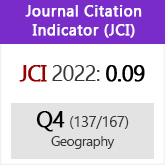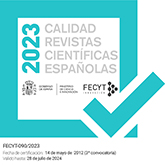The routes of the wine of the Empordà and the Priorat and their relational dynamics. Two destinations with different degree of development of the enologic tourism and similar relational dynamics
DOI:
https://doi.org/10.3989/estgeogr.201422Keywords:
tourisme, routes touristiques, enotourisme, relations sociales, analyse de réseaux sociaux, développement localAbstract
Dans les destinations touristiques, les nouvelles nécessités et les motivations des touristes, de plus en plus expérimentés, qu’ils demandent certaine personnalisation des produits touristiques, le développement de nouveaux produits est l’une des stratégies les plus généralisées. Ainsi, les routes du vin se présentent comme une activité du tourisme enologique qui satisfait ces demandes. Par cela, avec l’objectif de vérifier si la dynamique créée autour des relations générées dans les réseaux sociaux des agents impliqués avec le développement de ce type de tourisme (producteurs, associations, bureaux de tourisme et institutions publiques) a une relation directe avec le degré de développement de même, au travail présent on a réalisé l’analyse de ces réseaux sociaux et de ses contenus dans l’Empordà et le Priorat, ses résultats étant comparés et en se confirmant que il y a une relation directe entre les deux facteurs –développement et dynamique relational– avec indépendance du niveaux du développement du tourisme dans la destination.
Downloads
References
Acercosa, M. A. (2006): Marketing de destinos turísticos. Madrid, MAD.
Alonso, J. L. (2003): "Redes y procesos de innovación en las comarcas vinícolas de Castilla y León: el ejemplo de la D.O. Bierzo". BAGE, 36, pp. 43-60.
Alonso, J. L. y Méndez, R. (coord.) (2000): Innovación, peque-a empresa y desarrollo local en Espa-a. Madrid, Editorial Civitas.
Bigné, E.; Font, X. y Andreu, L. (2000): El marketing de los destinos turísticos. Madrid, ESIC.
Boniface, P. (2003): Tasting Tourism: Travelling for Food and Drink. Aldershot, Ashgate Publishing Ltd.
Borgatti, F. F.; Everett, M. G. y Freeman, C. (2002): Ucinet for Windows: Software for Social Networks Analysis. Harvard, Harvard University Press.
Butler, R. (1980): "The concept of a tourism area cycle of evolution: implications for the management of resources". Canadian Geographer, 24, pp. 5-12. http://dx.doi.org/10.1111/j.1541-0064.1980.tb00970.x
Castillo, M. (2007): "Enoturismo: mucho más que una moda". Revista Alimarket, 207, pp. 59-65.
Chulwon, K. y Taesuk, L. (2005): "Exploring Four Dimensional Sources of Destination Competitiveness". International Journal of Tourism Sciences, 5/1, pp. 105-130.
Ejarque, J. (2005): Destinos turísticos de éxito: diseño, creación, gestión y marketing. Madrid, Pirámide.
Elías, L. V. (2006): El turismo del vino. Otra experiencia de ocio. Bilbao, Editorial Deusto. Fernández Portela, J. (2012): "Cambios en la industria y en el paisaje vitivinícola de la Denominación de Origen de Cigales (Castilla y León, Espa-a)". Estudios Geográficos, LXXIII/272, pp. 63-90.
Frank, O. y Snidjers, T. (1994): "Estimating the Size of Hidden Populations Using Snowball Sampling". Journal of Official Statistics, 10/1, pp. 53-67.
Granovetter, M. (1976): "Network Sampling: some first steps". American Journal of Sociology, 83, pp. 727-729. http://dx.doi.org/10.1086/226224
Hashimoto, A. y Telfer, D. J. (2006): "Selling Canadian Culinary Tourism: Branding the Global and the Regional Product". Tourism Geographies, 8/1, pp. 31-55. http://dx.doi.org/10.1080/14616680500392465
Hanneman, R. A. (2000): Introducción a los métodos del análisis de redes sociales. Riverside, California University.
Haythornthwaite, C. (1996): "Social network analysis: An approach and technique for the study of information exchange". Library and Infor mation Science Research, 18, pp. 323-342. http://dx.doi.org/10.1016/S0740-8188(96)90003-1
Hjalager, A. y Richards, G. (2002): Tourism and Gastronomy. London, Routledge. Institut d'Estadística de Catalunya (Idescat) (2012): Estadístiques territorials. Disponible en: http://www.idescat.cat (Fecha de consulta: 10 de Octubre de 2014).
Institut Català del Vi (Incavi) (2012): Estadístiques d'enoturisme. Barcelona, INCAVI. International Culinary Tourism Association (ICTA) (2012): Statistics. Portland, ICTA Press.
Johns, N. y Clarke, V. (2001): "Mythology analysis of boating tourism". Annals of Tourism Research, 28/2, pp. 334-359. http://dx.doi.org/10.1016/S0160-7383(00)00063-3
Kivela, J. y Crotts, J. C. (2006): "Tourism and gastronomy: gastronomy's influence on how tourists experience a destination". Journal of Hospitality & Tourism Research, 30/3, pp. 354-377. http://dx.doi.org/10.1177/1096348006286797
Kwangmin, P. y Jinhoo, K. (2010): "The Firm Growth Pattern in the Restaurant industry. Does Gibrats Law Hold?". International Journal of Tourism Sciences, 10/3, pp. 49-63.
Long, L. M. (ed.) (2004): Culinary tourism. Lexington, University Press of Kentucky Martínez Puche, A. y Jover, M. J. (coord.) (2012): "Cine y enoturismo: Representación, identidad y promoción de los territorios del vino", en A. Martínez Puche (ed.): Territorios de cine. Desarrollo local, tipologías turísticas y promoción. Alicante, Publicaciones de la Universidad de Alicante, pp. 199-220.
López-Guzmán, T. y Sánchez, S. M. (2008): "La creación de productos turísticos utilizando rutas enológicas". Pasos. Revista de Turismo y Patrimonio Cultural, 6/2, pp. 159-171.
McBee, S. (2002): To Lead Is To Serve: How To Attract Volunteers & Keep Them. South Fallsburg, NY, Shar McBee.
McCurley, S. y Lynch, R. (1996): Volunteer Management: Mobilizing All the Resources of the Community. Downers Grove, IL, Heritage Arts Publishing.
Merinero, R. y Pulido, J. I. (2009): "Desarrollo Turístico y dinámica relacional. Metodología de análisis para la gestión activa de destinos turísticos". Cuadernos de Turismo, 23, pp. 173-193.
Middleton, V. T. C. (1994): Marketing in Travel and Tourism. Oxford, Butterworth-Heinemann.
Mkono, M. (2011): "The Offering of Food in Touristic Eatertainement: A Netnography". Tourist Studies, 11/3, pp. 253-270. http://dx.doi.org/10.1177/1468797611431502
Molina, J. L. (2001): El análisis de redes sociales. Una introducción. Barcelona, Ediciones Bellaterra.
Mondéjar, J. A. y Sevilla, C. (2008): "Enoturismo: un producto emergente con gran potencial de crecimiento en España". Cim.economía, 13, pp. 305-327.
Observatorio Turístico Rutas del Vino de España (2010): Estudio de la Oferta Enoturística de las Rutas del Vino de España – 2º semestre 2009. Madrid, Turespaña y Acevin.
Requena, F. (2003): Análisis de redes sociales. Orígenes, teorías y aplicaciones. Madrid, Centro de Investigaciones Sociológicas/Siglo XXI.
Richards, G. (2002): "Gastronomy: An essential ingredient in tourism production and consumption?", en A. M. Hjalager y G. Richards, G. (eds.): Tourism and gastronomy. London, Routledge, pp. 3-20.
Ritchie, B. y Zins, M. (1978): "Culture as determinant of the attractiveness of a tourism region". Annals of Tourism Research, 5, pp. 226-237. http://dx.doi.org/10.1016/0160-7383(78)90223-2
Scott, N.; Baggio, R. y Cooper, C. (2008): Network Analysis ant Tourism. From Theory to Practice. Tonawanda, NY, Channel View Publications.
Smith, S. y Xiao, H. (2008): "Culinary Tourism Supply Chains: A Preliminary Examination". Journal of Travel Research, 46/3, pp. 289-299. http://dx.doi.org/10.1177/0047287506303981
Vogeler, C. y Hernández, E. (2000): El mercado turístico: estructura, operaciones y procesos de producción. Madrid, Centro de Estudios Ramón Areces.
Warde, A. (1997): Consumption, Food and Taste. London, Sage.
Wolf, E. (2002): Culinary tourism: A tasty economic proposition. Portland, Culinary Tourism Taskforce,
Zillinger, M. (2007): "Tourist routes: A Time-Geographical Approach on German Car-Tourists in Sweden". Tourism Geographies, 9/1, pp. 64-83. http://dx.doi.org/10.1080/14616680601092915
Downloads
Published
How to Cite
Issue
Section
License
Copyright (c) 2014 Consejo Superior de Investigaciones Científicas (CSIC)

This work is licensed under a Creative Commons Attribution 4.0 International License.
© CSIC. Manuscripts published in both the printed and online versions of this Journal are the property of Consejo Superior de Investigaciones Científicas, and quoting this source is a requirement for any partial or full reproduction.All contents of this electronic edition, except where otherwise noted, are distributed under a “Creative Commons Attribution 4.0 International” (CC BY 4.0) License. You may read here the basic information and the legal text of the license. The indication of the CC BY 4.0 License must be expressly stated in this way when necessary.
Self-archiving in repositories, personal webpages or similar, of any version other than the published by the Editor, is not allowed.
















